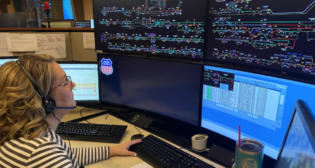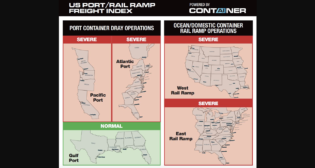
Rebuilding an empire
Written by Bruce E. Kelly, Contributing EditorBNSF is expanding its Northern Corridor to meet increasing demand.
It should come as no surprise that BNSF Railway has found itself moving commerce across its Northern Corridor at levels that often exceed practical capacity. This route was designed from the start, more than a century ago, to outperform its competitors, and to not simply reach the West Coast of America but to facilitate
trade to Asia and beyond. But even James J. Hill, the “Empire Builder” of the Great Northern Railway, which now serves as the centerpiece of BNSF’s Northern Corridor network, did not foresee a time when so much containerized merchandise, grain, coal, and now crude oil would travel his rails that passenger trains would be forced to reschedule around it.
After more than a year of routinely late service, Amtrak’s Empire Builder began operating under a modified schedule this spring in an effort to coordinate better with BNSF’s heavy traffic and ongoing track expansion work. Localized rerouting and bus substitution have also taken place. Despite what numerous headlines have said, congestion from unit crude trains is not solely to blame. Intermodal and grain, which are bread and butter to BNSF in the Northwest (representing slightly more than half of the Northern Corridor’s daily train count), saw increases in recent months compared with the same period a year ago.
The remaining 45% or so of BNSF’s Northern Corridor trains are a mix of manifests, automobiles, coal, and crude. There is, of course, a higher concentration of unit crude trains swarming BNSF’s trackage in the heart of Bakken shale country in North Dakota, but once they disperse toward their destinations, the number of crude trains traveling a significant distance over the Northern Corridor is small (currently one to three loaded trains to the Northwest each day) compared to the overall traffic profile. However, those crude train numbers are expected to increase as new receiving terminals come on line.
BNSF Vice President Capacity Planning and Operations Research Rollin Bredenberg says his railroad has partnered with the Great Northern Corridor Coalition, a joint venture of ports and transportation departments in eight states whose goal is “to promote regional cooperation, planning, and shared project implementation for moving freight.”
Bredenberg says, “The corridor supports many products including agriculture, forest, consumer, energy, industrial, iron and steel, minerals, automotive and machinery, and aerospace. BNSF understands how trade prosperity in the Pacific Northwest is directly linked to the level of rail and roadway infrastructure serving the region. In 2013, BNSF moved 221 million tons of freight over the Northern Corridor.”
BNSF occasionally diverts excess Chicago-PNW trains to partner Montana Rail Link, adding to the regular Kansas City/Texas/Powder River Basin traffic that MRL already conveys into the Northwest for BNSF. But nearly all of the Northern Corridor’s traffic eventually comes together again at “The Funnel,” a 70-mile segment between Sandpoint, Idaho, and Spokane, Wash., only 48 miles of which has two main tracks, and through which all of those BNSF/MRL trains must pass—anywhere from 50 to 70 trains, or more, per day.
Traffic growth on the Northern Corridor is coming not just from Bakken crude. The Northwest has become an increasingly popular source for fruits and vegetables that are expedited to East Coast markets. UP and Railex staked their joint claim in that business in 2006 with a 210,000-square-foot warehouse at Wallula, Wash., which loads and unloads unit trains of refrigerated boxcars. BNSF and partner Rail Logistics took a different approach in 2010 by launching the Cold Train Express out of Quincy, Wash., which stacks refrigerated containers onto railcars for pickup by high-priority intermodal trains. Food products via Cold Train receive BNSF’s fastest service to the Midwest, and are ultimately distributed as far east as Boston. Business is now at roughly 7,000 containers annually.
The Port of Quincy built its intermodal facility in 2005 with the intention of shipping perishables, hay, and other Washington ag products west toward Pacific export. But BNSF wouldn’t commit to providing short-haul intermodal service over its steep and congested Stevens Pass route. Long-haul to Chicago was found to be more viable. A major expansion of the Cold Train terminal is now planned, which the Port of Quincy says will include installation of three additional intermodal tracks to enable simultaneous loading and unloading of a 7,500-foot train. The Port says, “The project would also include a new track to allow trains of up to 8,000 feet to pull off of the main line at Quincy for arrival and departure in one piece, a 7,500-foot-long setout/pickup track, and expanding the terminal surface area to provide for more container storage.”
There’s potential for traffic growth out of Kalispell, Mont., where the Flathead County Economic Development Authority is seeking TIGER funding for a proposed $24 million rail-served industrial park. FCEDA says, “Although Kalispell is just off the Northern Corridor, it currently has very few locations available for new businesses requiring rail access. The FCEDA Rail Park will remedy that by creating shovel-ready sites for new and expanding businesses.” The park would attract on-site manufacturers, and also include a transload facility to serve other businesses within a 100-mile radius. FCEDA notes, “BNSF has committed $500,000 to the project and countless hours in designing the park’s infrastructure.” Kalispell lies at the end of a 14-mile branch operated by Watco subsidiary Mission Mountain Railroad, which already moves lumber, grain, and other traffic to the BNSF interchange at Columbia Falls.
The latest fall/winter traffic surge, which was impacted by periods of extreme cold and heavy snow, magnified BNSF’s awareness of three critical issues affecting its Northern Corridor: crew availability, motive power supply, and route capacity. BNSF says the first two points are being addressed by hiring 5,000 new employees and purchasing more than 500 locomotives in 2014. Additional locomotives are being borrowed from other railroads and from equipment leasing firms.
BNSF President and CEO Carl Ice told Railway Age in March, “More than $900 million will be invested during 2014 in expansion and maintenance in our Northern Corridor alone, which has become a significant growth corridor for many of the industries we serve.” During 2012-2013, BNSF upgraded existing sidings, added new sidings, and added yard tracks in North Dakota and eastern Montana. For 2014, much of the focus is on eastern Washington, where BNSF is adding close to 20 miles of new track in the form of sidings or second main line. All of this is follow-up to the 50-plus miles of second main track that BNSF installed in eastern Washington and northern Idaho during the late 1990s.
Laying new track wherever possible will not eliminate every capacity constraint found along the Northern Corridor. The 7.8-mile-long Cascade Tunnel under Stevens Pass in the Washington Cascades and the 7.0-mile Flathead Tunnel in northwest Montana represent sections of single track that would be costly to duplicate or widen. Cascade Tunnel has additional capacity issues due to its steep grade and 25 mph freight speed, and also because it takes five to 30 minutes (depending on traffic direction) to ventilate the tunnel between each train.
At the northernmost point on the corridor, where BNSF follows the Kootenai River through a deep canyon, trains are limited to 30 mph across a 19-mile stretch between Yakt, Mont., and Crossport, Idaho, because of nearly constant reverse curvature. Trains can slip past each other at two sidings within this speed zone, but “The Canyon,” as it’s called by dispatchers and train crews, puts a crimp on capacity that could only be resolved by complete doubletracking (a daunting option considering the narrow right-of-way and sensitive river habitat) or by tunneling nearly three miles through solid rock to bypass the most northerly segment of this twisting main line.
Why not gain new capacity by utilizing some of the region’s long-abandoned routes? BNSF spent nearly $150 million to restore the former NP line over Stampede Pass in 1996, creating an optional route for trains to and from western Washington. Stampede is now used to back-haul empty grain, oil, and coal trains eastward, freeing up precious space on its less-steep Pasco-Vancouver-Portland route for loaded unit trains heading west. The former SP&S route between Fish Lake (on the outskirts of Spokane) and Pasco, which BN abandoned in the late 1980s, would provide a smoother grade across eastern Washington for tonnage like grain and coal. But rather than reclaim what is now a 120-mile public trail and install new track and signals, BNSF is moving forward with the capacity it continues to create on its existing route between Spokane and Pasco.
Could BNSF do in the Montana Rockies what it did in Washington’s Cascades? Track over Homestake Pass, 10 miles east of Butte, Mont., has been out of service since 1982. It would provide a third way over the Rocky Mountains for BNSF’s east-west traffic, but it would be the toughest, and highest. BNSF’s current route via 5,213-foot high Marias Pass has a predominantly 1.0% ascending grade for westbounds and 1.8% for eastbounds. MRL via 5,547-foot Mullan Pass has 10 miles of 2.2% grade against westbounds and eight miles of 1.4% against eastbounds. But Homestake Pass, elevation 6,329 feet, would force westbounds to climb 18 miles of 2.2%, and eastbounds six miles of 2.2%, with curves more frequent and tighter than either Marias or Mullan.
When Montana state officials inquired in 2012 about the chances of reopening Homestake, BNSF’s response was, “As we consider additional rail capacity, we will evaluate that line and other potential options to determine the best economical and operational alternatives to expand capacity to accommodate increased train traffic.”
BNSF’s Bredenberg now tells Railway Age, “There are no plans to reopen the line at this time. Steeper and longer grades and severe track curvature increase fuel consumption and rail maintenance costs.” MRL President Thomas Walsh agrees, saying, “At this point, we do not anticipate the opening of the line over Homestake Pass. However, in the event it was open, traffic would likely flow directionally”—meaning, trains would travel one way via Mullan Pass, and the other way via Homestake. Just not now. Not yet, anyway.
It’s been a difficult couple of years for BNSF as it races to open new lanes for traffic while its existing lanes are bursting at the seams. But any company that can afford to invest a billion dollars on expansion, and has new customers eagerly lining up at the door, must be doing something right. Once the dust from all that trackwork begins to settle, we’ll have a clearer view of a world-class railway that’s become a bigger and busier success than its original builders could have ever imagined.



